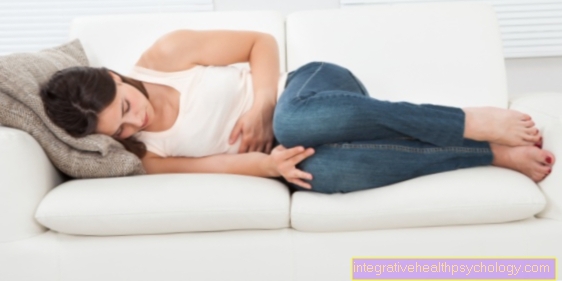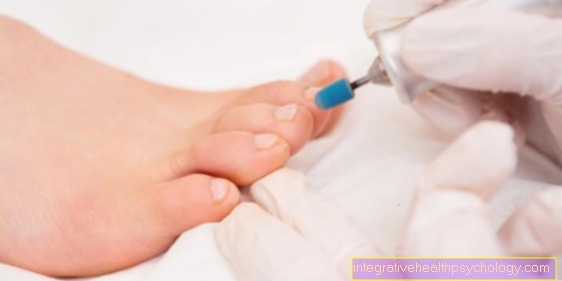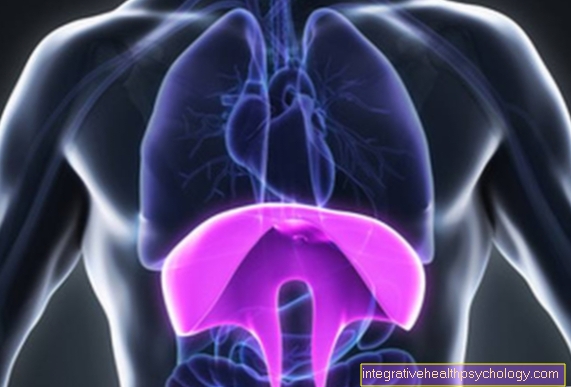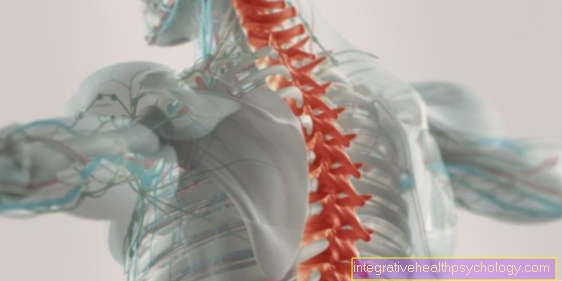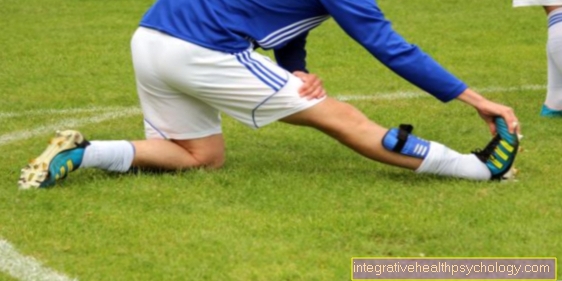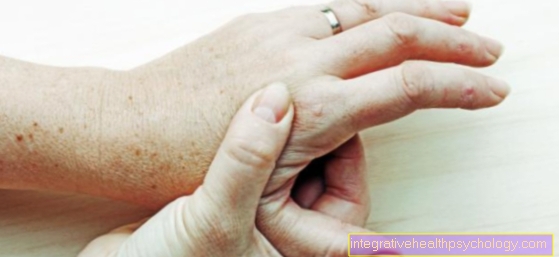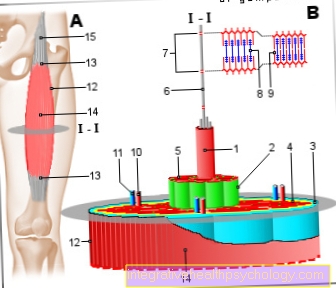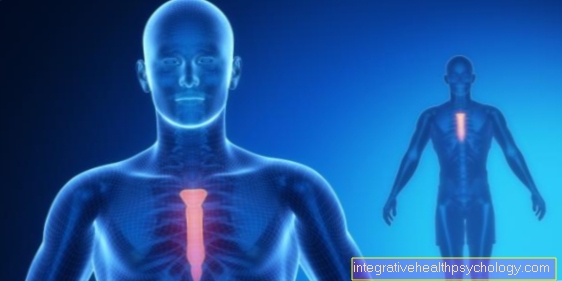Dizziness when stooping
introduction
Dizziness when stooping is understood as a feeling of dizziness that occurs when the body changes quickly to a stooped position. In the majority of cases, dizziness is described as vertigo, and people feel as if they are sitting on a carousel.
There are various possible reasons for this. The most common is the so-called benign positional vertigo, in which a disturbance in the equilibrium organ means that incorrect information about the body position is sent to the brain. But other causes, such as poor blood circulation, can also come into question.
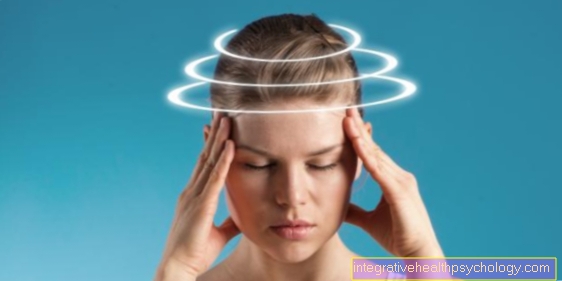
causes
There are several possible causes for dizziness when stooping.
In most cases, it is a so-called benign positional vertigo. This occurs in a seizure manner when there are sudden changes in the position of the body and is therefore a typical cause of dizziness when stooping. The dizziness can also occur when turning the head, for example in bed. The reason for this lies in a dysfunction of the equilibrium organ. Here, so-called ear stones can loosen, which means that incorrect information about the body position is sent from the balance organ to the brain. Other diseases of the organ of equilibrium are also possible as causes, but by no means as typical as benign positional vertigo.
Other possible causes are weaknesses in the circulatory system. There are many different types of this, none of which are typical of vertigo that occurs when you stoop. Possible causes are a disturbance in blood pressure adjustment when changing position, hypoglycaemia or incorrectly adjusted blood sugar, venous insufficiency or the side effects of medication.
Accompanying circumstances
While getting up
If dizziness occurs when standing up, this must be differentiated from dizziness caused by actually bending over, as the causes are usually very different.
Dizziness when standing up is most commonly caused by a failure to adapt blood pressure to changes in body position. This leads to a sudden drop in blood pressure, which means that the head and the brain in particular are supplied with too little blood for a few seconds. The dizziness is an expression of this blood shortage and usually lasts only a few seconds.
Read more on this topic:
- Symptoms of low blood pressure
To look up
If dizziness occurs after stooping and looking up, there are various possible causes, just like stooping, but the most common is benign positional vertigo. Here, so-called ear stones loosen in the organ of equilibrium, whereby incorrect information from the organ of equilibrium is passed on to the brain.
This disease is typically associated with dizziness when the head moves suddenly or when the position changes. Therefore, dizziness when stooping and looking up again is most likely to cause this cause. Other signs include dizziness when turning over in bed.
With your head back
If the dizziness occurs when bending over and then laying the head back, there are two main reasons for this.
The benign positional vertigo as a disease of the organ of equilibrium is characterized by the sudden occurrence of vertigo when the head changes position. Therefore, it can often lead to dizziness in such situations.
Another common cause of these circumstances is entrapment of a nerve in the cervical spine. This can be caused, for example, by tension and, depending on the extent of the symptoms, lead to recurring dizziness.
You may also be interested in this topic:
- Dizziness from tension
Concomitant symptoms
If dizziness occurs when stooping, other accompanying symptoms may occur. Those affected often go black or see lightning, for example. Such visual disturbances usually only occur during the dizzy spell.
Furthermore, some people break into sweats and ring in their ears. A faster beating heart or even a palpable palpitations can also occur in the event of dizziness when bending over. Headaches, nausea or even vomiting are possible.
Also read:
- Dizziness and blurred vision
- Dizziness with racing heart
a headache
Dizziness when stooping is more likely to be accompanied by headaches.
The cause of the combination of these three symptoms is often a dysregulation of the blood pressure with a rapid change in body position. This leads to a short-term insufficient supply of blood to the brain, especially in older people. This reacts with dizziness and in many cases with a headache as the brain temporarily lacks oxygen.
More information on this topic:
- Dizziness and headache
nausea
If nausea occurs in addition to dizziness when stooping, the cause is usually in the balance organ.
In the case of illnesses, especially benign positional vertigo, incorrect information is sent to the brain. This leads to a pronounced feeling of dizziness, which is often associated with nausea. This is exacerbated by the fact that the brain is overwhelmed with organizing the information of the balance organ and that which it receives through the eyes. Taking Vomex, for example, can be helpful against acute nausea.
therapy
Treatment for dizziness when stooping depends on the underlying cause.
In the event of an acute attack of dizziness, most people will find it helpful to sit down for a few minutes, preferably in the fresh air. Freezing from a specific point may also be helpful. This gives the brain the opportunity to orientate itself in space again. Furthermore, in many cases, simple tactics such as avoiding changes in the position of the head too quickly and drinking enough fluids can be helpful.
If the vertigo is caused by benign positional vertigo when stooping, there are special techniques with which the loosened ear stones can be brought back into the correct positions. These techniques are also known as positioning maneuvers and can be performed with a doctor. After medical advice, there is also the possibility of doing this independently at home.
If the blood pressure is too low, care should be taken to ensure that the circulation is sufficiently kept going. Alternating showers and sufficient exercise can have a supportive effect.
Also read:
- Exercises against positional dizziness
- Vertigo training
- Medication for dizziness
homeopathy
There are several homeopathic remedies that can reduce dizziness that occurs when stooping.
These include, for example, Rhus toxicodendron, which reduces dizziness when changing body positions. Silicea can also be helpful, as it has a positive effect on dizziness in the neck area. Calcium carbonicum is also a possibility from the homeopathic area. This remedy reduces the dizziness that occurs when changing the position of the head.
Course of disease
The course of dizziness when stooping depends on the underlying cause.
In most cases, the course is quite mild, as the dizziness is rarely so pronounced that it severely restricts the person concerned in their everyday life. The benign positional dizziness is often the underlying cause of the dizziness that occurs when stooping. This disease of the organ of equilibrium can in most cases be eliminated with simple positioning maneuvers. As a result, the course of the disease is correspondingly uncomplicated and short.
diagnosis
Several components are important in making a diagnosis of dizziness when stooping.
During the anamnesis, i.e. the doctor-patient conversation, the exact circumstances under which the dizziness occurs can be clarified. This is very important as the cause varies depending on whether the dizziness actually occurs when you stoop or not when you stand up. Depending on the suspicion of the underlying cause, further tests may be helpful. For example, the examination of the organ of equilibrium with some tests, as well as a long-term measurement of blood pressure, are possible.
Duration and forecast
If dizziness occurs when stooping, the duration of the symptom depends on the underlying cause.
The vertigo attack itself usually lasts from seconds to minutes and then subsides again. The most common cause of dizziness when stooping is benign positional dizziness, the treatment of which can be carried out quickly and easily. Accordingly, the duration is usually a few weeks and the prognosis is extremely favorable. The likelihood of developing benign positional vertigo again may increase, but this is not too dangerous in view of the good treatability.

